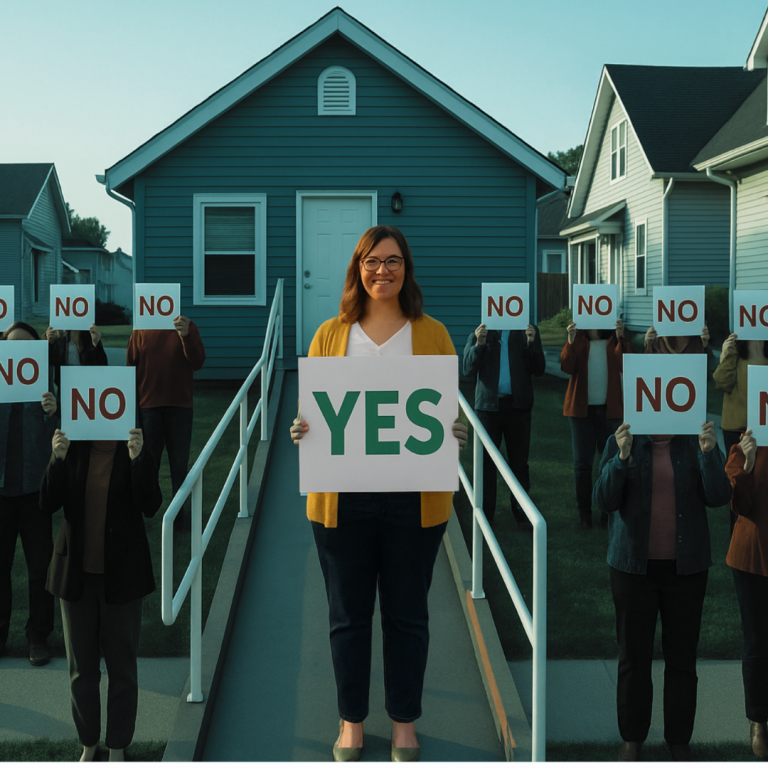
Over the past three months, we at Accessible Housing have had the privilege of connecting with some of our most valued housing partners to discuss the current landscape — and future possibilities — for accessible and affordable housing in Calgary.
Through conversations with Norfolk Housing Association, Onward Homes, and Vivenda Group, we explored what it takes to create inclusive communities that are not just places to live, but places to thrive.
Here are our takeaways:
Shared Vision: Quality, Affordable, Vibrant Communities
All three organizations echoed a shared goal: to build high-quality, affordable, and vibrant communities. At the heart of this mission is a recognition that housing is about more than bricks and mortar — it’s about people, relationships, and belonging.
“We’re not just landlords — we’re community builders.” – Norfolk Housing Association
The Power of the Mixed-Income Model
Norfolk Housing and Onward Homes has embraced a mixed-income model, the idea here is people from different income levels live together in the same building or community. This model blends market-rate, affordable, and sometimes deeply subsidized rental units in one location. This model doesn’t just help balance affordability; it builds diverse, sustainable communities with low turnover and strong social connections. Also Vivenda Group works closely with the Bridge to Home Team in supporting their resident
“Circumstances change. A tenant might move between being a market renter and a non-market renter. That flexibility makes it work.” – Norfolk Housing Association
Collaboration is Key
All three partners emphasized the critical role that partnerships — especially with programs like Bridge to Home — play in tenant success.
“Why do it alone? Accessible Housing has the expertise and resources. They understand the needs of people with mobility issues, and they’re always ready to help.” – Vivenda
Onward Homes echoed this sentiment, highlighting how constant communication with Bridge to Home helps ensure placements are successful and long-lasting.
“Without partners like Bridge to Home, so many would fall through the cracks.” – Onward Homes
Designing for Accessibility
The importance of intentional design came through clearly. All three partners prioritize accessible features like:
- No-step entrances
- Extra-wide doorways
- Lower counters and appliances
- Fully accessible bathrooms
Onward Homes spoke about the necessity of planning accessible design from the ground up, rather than retrofitting — which often comes with greater challenges and costs.
“We work with our builders and architects to integrate accessibility into the design process from the start.” – Onward Homes
Norfolk and Vivenda have also worked with our RAD program to upgrade older buildings, incorporating universal design features and improving the lived experience for tenants with physical disabilities.
Flexibility & Support Make It Work
Beyond the bricks, flexibility and support emerged as critical themes. Whether it’s modifying units to meet a tenant’s changing needs, or offering wraparound services through Bridge to Home, these housing providers are focused on adaptability and holistic support.
“Working with Bridge to Home has been invaluable. It’s not just about housing — it’s about supporting the tenant’s broader needs.” – Vivenda
Barriers to Accessible Housing — and How to Overcome Them
Despite the progress, our partners also highlighted some key challenges:
- Misconceptions around the cost of accessible design
- Zoning and parking regulations that make accessibility more expensive or difficult to implement
- A shortage of accessible units, especially for long-term tenants aging in place
Onward Homes pointed out that even small policy shifts or funding incentives could encourage broader adoption of accessible design.
“Developers often think accessible design is too costly. But with planning and the right support, it’s absolutely doable.” – Onward Homes
Looking Ahead: A Collaborative Future
The common thread through all these interviews? A commitment to doing the right thing — together. Each partner sees a future where collaboration, flexible models, and intentional design make inclusive housing not the exception, but the norm.
“We can’t do this work alone. But together, with the right partnerships, we can build something lasting — and truly inclusive.”
– Norfolk Housing Association
Final Thoughts
At Accessible Housing, we’re so grateful for the dedication and openness of our partners. Through collaboration, shared vision, and an unwavering commitment to inclusion, we’re building more than housing — we’re building home.
Let’s keep the conversation going. If you’re a developer, builder, or housing provider interested in inclusive housing, let’s connect. Together, we can create a Calgary where everyone belongs.
